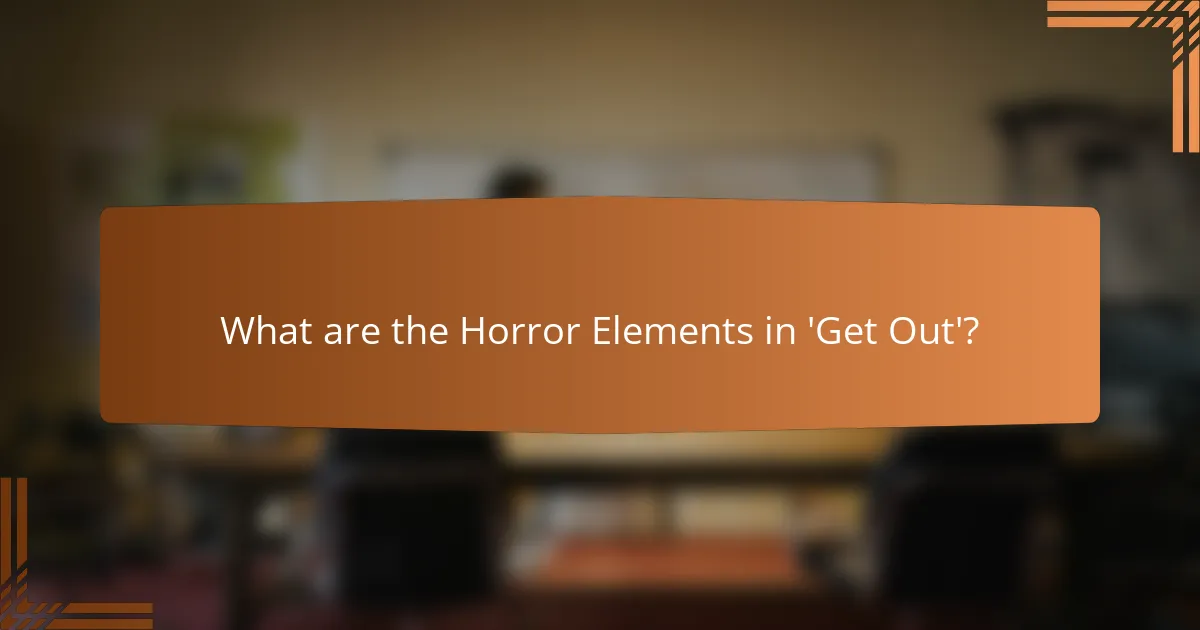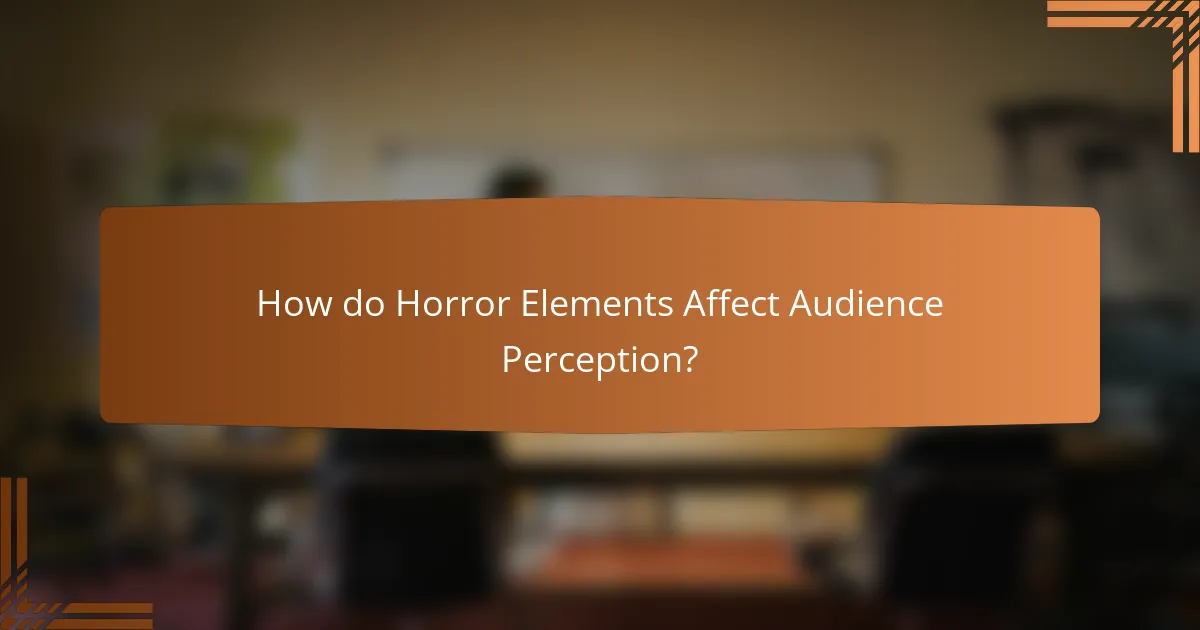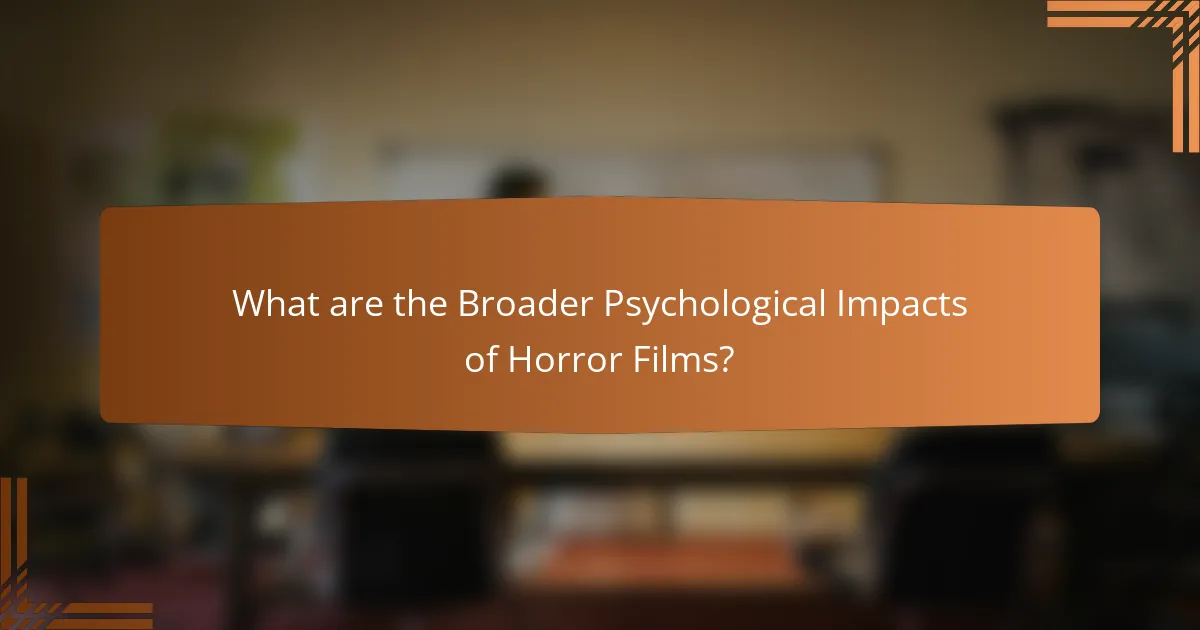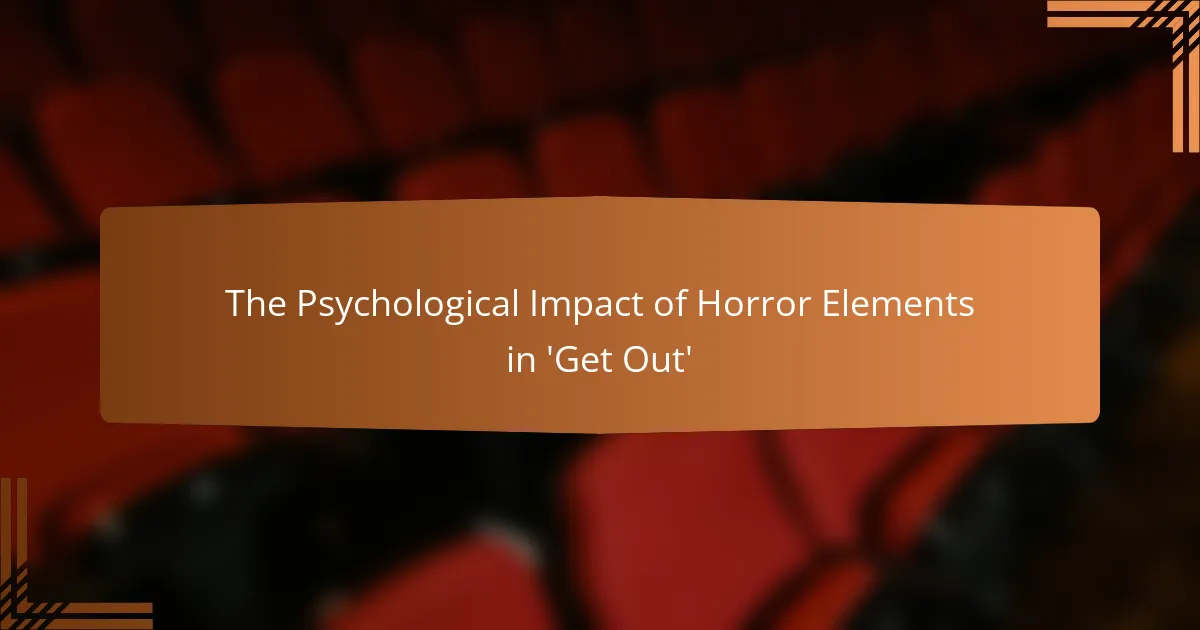The article examines the psychological impact of horror elements in the film “Get Out,” focusing on how these elements shape audience perception and emotional responses. Key horror components include psychological manipulation, social commentary, and body horror, which collectively create a pervasive atmosphere of dread and enhance the film’s critique of racism and cultural appropriation. The article discusses how these horror elements engage viewers on a psychological level, influencing their emotional reactions and perceptions of safety. It also highlights the broader psychological effects of horror films, such as fostering resilience and facilitating social discussions among audiences. Overall, the exploration of these themes underscores the significant role horror plays in shaping viewer experiences and understanding societal issues.

What are the Horror Elements in ‘Get Out’?
The horror elements in ‘Get Out’ include psychological manipulation, social commentary, and body horror. Psychological manipulation is evident through the protagonist’s experiences of gaslighting and isolation. Social commentary critiques racism and cultural appropriation, creating a sense of unease. Body horror manifests through the surgical procedures that strip individuals of their identities. These elements combine to create a pervasive atmosphere of dread. The film’s depiction of fear rooted in societal issues enhances its horror impact. Each element contributes to the overall tension and psychological distress experienced by the audience.
How do these horror elements contribute to the film’s narrative?
Horror elements in ‘Get Out’ enhance the film’s narrative by creating psychological tension and emotional depth. The use of suspenseful music builds anxiety, making viewers feel uneasy. Visual imagery, such as the haunting sunken place, symbolizes loss of agency. These elements evoke fear, reflecting societal issues around racism. The character’s experiences mirror real-world injustices, adding layers to the narrative. Moreover, the horror tropes serve as metaphors for psychological trauma. This combination deepens audience engagement and provokes critical thought about race relations. Overall, horror elements are integral to conveying the film’s themes and emotional impact.
What specific horror tropes are utilized in ‘Get Out’?
‘Get Out’ utilizes several specific horror tropes. These include the “body snatching” trope, where characters are physically taken over by others. The film also employs the “white savior” trope, subverting expectations around race and power dynamics. The “uncanny” is present, creating discomfort through familiar yet distorted imagery. Psychological manipulation is another key trope, showcasing the protagonist’s mental struggle against external forces. The film’s use of isolation amplifies fear, as the main character is cut off from his support system. Additionally, the “twist ending” trope is significant, revealing shocking truths that redefine the narrative. Each of these tropes contributes to the film’s exploration of racial tensions and psychological horror.
How do these tropes enhance the storytelling experience?
Tropes enhance the storytelling experience by creating familiar frameworks that engage audiences. They establish expectations, allowing viewers to connect emotionally with characters and plot. In ‘Get Out’, tropes like the “fear of the unknown” amplify tension and suspense. This heightens the psychological impact on the audience, making them more invested in the narrative. The use of social commentary tropes also deepens the story’s meaning. It encourages viewers to reflect on real-world issues, such as racism and identity. By blending horror with social critique, ‘Get Out’ becomes a multifaceted experience. Audience reactions to these tropes validate their effectiveness in enhancing storytelling. Research shows that horror tropes can evoke strong emotional responses, making narratives more impactful.
What psychological themes are explored through horror elements?
Horror elements in ‘Get Out’ explore psychological themes such as fear of the unknown, racial anxiety, and identity conflict. Fear of the unknown manifests through the unsettling atmosphere and mysterious events. Racial anxiety is highlighted by the protagonist’s experiences in a predominantly white environment. This theme reflects real societal tensions and prejudices. Identity conflict arises as characters grapple with their sense of self in oppressive situations. The film uses these themes to evoke deep emotional responses, making the horror relatable and impactful. These psychological explorations resonate with audiences, validating their fears and experiences in a nuanced manner.
How does ‘Get Out’ address themes of fear and anxiety?
‘Get Out’ addresses themes of fear and anxiety through its exploration of racial tensions and psychological manipulation. The film creates a pervasive sense of dread by depicting a Black man’s experience in a predominantly white environment. This setting amplifies feelings of isolation and vulnerability. The character Chris faces subtle yet insidious forms of racism, which heighten his anxiety. The use of suspenseful music and unsettling visuals further intensifies the emotional impact. Additionally, the concept of the “sunken place” symbolizes a loss of control, evoking existential fear. Through these elements, ‘Get Out’ effectively portrays the psychological toll of systemic racism and personal trauma.
What role does social commentary play in the psychological impact?
Social commentary significantly shapes the psychological impact of horror elements in ‘Get Out’. It addresses societal issues such as racism and identity. This commentary creates a sense of unease and reflection in viewers. The film’s portrayal of microaggressions intensifies psychological tension. It forces audiences to confront uncomfortable truths about race relations. Research indicates that social commentary in horror can enhance emotional engagement. For instance, studies show that viewers often experience heightened anxiety when confronted with societal critiques. This connection between social themes and psychological response is evident in ‘Get Out’.

How do Horror Elements Affect Audience Perception?
Horror elements significantly shape audience perception by eliciting emotional responses. These elements, such as suspense, fear, and surprise, engage viewers on a psychological level. For instance, studies show that suspense can increase heart rates and heighten anxiety. According to research published in the Journal of Media Psychology, horror films often activate the amygdala, the brain’s fear center, influencing how audiences interpret scenes. This activation can lead to a heightened sense of awareness and vulnerability. Consequently, horror elements can alter viewers’ perceptions of safety and reality. In “Get Out,” the use of psychological horror amplifies themes of racial tension, making the audience more receptive to underlying social commentary. The combination of horror and societal issues enhances the overall impact, leading to a more profound understanding of the film’s message.
What emotions are elicited by the horror elements in ‘Get Out’?
The horror elements in ‘Get Out’ elicit emotions of fear, anxiety, and discomfort. These emotions arise from the film’s exploration of racial tension and societal issues. The use of suspenseful music amplifies the feeling of dread. The unsettling imagery creates a sense of unease throughout the narrative. Characters experience isolation, heightening the audience’s empathy and fear for their well-being. The psychological manipulation depicted evokes anxiety about trust and safety. Overall, the horror elements effectively engage viewers emotionally, creating a lasting impact.
How do these emotions influence viewer engagement?
Emotions significantly influence viewer engagement by shaping their response to the narrative. In horror films like ‘Get Out’, fear and anxiety can heighten attention and investment in the story. When viewers experience these emotions, they are more likely to remain focused on the unfolding events. Research indicates that heightened emotional states can lead to increased physiological responses, such as elevated heart rates. This physiological arousal further enhances the viewer’s connection to the film. Additionally, emotions can drive discussions and social sharing, increasing overall engagement with the content. In summary, the emotional impact of horror elements directly correlates with viewer involvement and response.
What psychological responses are triggered during key scenes?
Key scenes in ‘Get Out’ trigger various psychological responses, including fear, anxiety, and discomfort. These responses are elicited through tension-building techniques, such as unsettling music and sudden visual shifts. For instance, the scene where Chris first meets the family induces anxiety through the awkwardness of social interactions. The use of close-up shots amplifies the viewer’s sense of claustrophobia and unease. Additionally, the revelation of the “sunken place” triggers feelings of helplessness and despair. Research shows that horror films can activate the amygdala, leading to heightened emotional responses. The film’s portrayal of racial themes further intensifies these psychological effects, making the viewer confront societal fears. Overall, ‘Get Out’ effectively utilizes psychological triggers to evoke deep emotional reactions during key scenes.
What is the significance of suspense in ‘Get Out’?
Suspense in ‘Get Out’ is crucial for building tension and engaging the audience. It enhances the psychological horror by creating an atmosphere of uncertainty. This uncertainty reflects the main character’s anxiety about his surroundings. Key scenes utilize suspense to foreshadow danger, heightening emotional stakes. The film’s pacing amplifies suspense, keeping viewers on edge. Techniques such as prolonged shots and sudden sound cues contribute to this effect. The suspense leads to a deeper exploration of themes like racial tension and identity. Overall, it serves to immerse the audience in the protagonist’s experience of fear and paranoia.
How does suspense build tension throughout the film?
Suspense builds tension throughout the film by creating uncertainty and anticipation. The film employs pacing to gradually reveal information, keeping viewers on edge. Key scenes use ominous music and sound design to enhance feelings of dread. Visual cues, such as close-ups and shadows, contribute to a sense of impending danger. The protagonist’s vulnerability is highlighted, making the audience empathize with his plight. Unpredictable plot twists further heighten suspense, as viewers cannot anticipate what will happen next. The combination of these techniques effectively keeps the audience engaged and anxious throughout the film.
What techniques are used to create a sense of dread?
Techniques used to create a sense of dread include suspenseful pacing, unsettling sound design, and visual symbolism. Suspenseful pacing builds tension by delaying resolution. Unsettling sound design uses dissonant sounds to evoke discomfort. Visual symbolism often presents ominous imagery that foreshadows danger. These techniques are effectively utilized in ‘Get Out’ to enhance the viewer’s anxiety. For example, the film’s score features jarring notes that heighten emotional responses. Additionally, the use of close-up shots creates an intimate yet claustrophobic atmosphere. Each technique contributes to an overarching feeling of impending doom.

What are the Broader Psychological Impacts of Horror Films?
Horror films can have significant broader psychological impacts on viewers. They often evoke strong emotional responses, including fear and anxiety. This reaction can lead to increased adrenaline levels, which some viewers find exhilarating. Research indicates that horror films can also serve as a form of catharsis, allowing individuals to confront their fears in a controlled environment.
Additionally, horror films may foster resilience by exposing viewers to frightening scenarios, thereby enhancing coping mechanisms. A study published in the journal “Psychology of Popular Media” found that regular exposure to horror can desensitize individuals to fear. This desensitization may contribute to a greater tolerance for stress in real-life situations.
Moreover, horror films can impact social dynamics. They often provoke discussions among viewers, creating a shared experience that can strengthen social bonds. Overall, horror films can influence emotional regulation, resilience, and social interaction among viewers.
How does ‘Get Out’ compare to other horror films in psychological impact?
‘Get Out’ has a profound psychological impact compared to other horror films. It uniquely blends social commentary with horror elements. The film addresses systemic racism, triggering deep emotional responses. Unlike traditional horror films that rely on jump scares, ‘Get Out’ builds tension through unsettling themes. This approach resonates with audiences on a personal level. Critics note its ability to evoke discomfort and reflection. The film’s narrative structure enhances its psychological depth. Studies highlight its effectiveness in provoking discussions about race and identity. Overall, ‘Get Out’ stands out for its psychological engagement and societal relevance.
What unique aspects of ‘Get Out’ amplify its psychological effects?
The unique aspects of ‘Get Out’ that amplify its psychological effects include its social commentary and character dynamics. The film explores themes of racism and exploitation, creating a sense of unease. This social critique resonates deeply with audiences, heightening emotional responses. The use of surreal horror elements, like the “sunken place,” evokes feelings of helplessness. Additionally, the film’s pacing builds tension effectively. The character interactions reveal underlying motives, enhancing suspense. These elements collectively create a psychologically gripping narrative that lingers with viewers.
How do cultural contexts influence the psychological reception of horror films?
Cultural contexts significantly influence the psychological reception of horror films. Different cultures have unique beliefs, values, and fears that shape how horror narratives are perceived. For instance, in Western cultures, themes of isolation and existential dread are prevalent in horror. In contrast, Eastern cultures may focus on supernatural elements and ancestral spirits.
Research shows that cultural background affects emotional responses to horror. A study by Zuckerman and Dey (2015) found that individuals from collectivist societies respond more intensely to horror films that emphasize community and familial bonds. This is due to their cultural emphasis on group identity and the fear of social alienation.
Conversely, individuals from individualistic cultures may resonate more with themes of personal survival and autonomy. Their psychological engagement with horror films often revolves around personal fears and individual challenges. Thus, cultural contexts create diverse frameworks for interpreting horror, impacting viewer engagement and emotional responses.
What lessons can be learned from the psychological effects of ‘Get Out’?
‘Get Out’ illustrates the psychological effects of racism and manipulation. The film employs horror to highlight societal issues. It demonstrates how fear can be rooted in real-life experiences. The protagonist’s journey reflects the anxiety of marginalized individuals. The use of suspense amplifies the sense of dread. This mirrors the psychological impact of systemic racism. The film encourages viewers to confront uncomfortable truths. It serves as a catalyst for discussions about race and identity.
How can filmmakers effectively use horror elements to convey messages?
Filmmakers can effectively use horror elements to convey messages by creating tension and evoking strong emotions. The use of suspenseful music and sound design heightens anxiety. Visual imagery, such as unsettling settings, reinforces themes of fear and discomfort. Symbolism within horror elements can represent deeper societal issues. For instance, “Get Out” uses the sunken place as a metaphor for racial oppression. Characters’ psychological struggles reflect broader cultural anxieties. The gradual reveal of horror elements allows audiences to engage with the underlying message. Historical context and real-life fears can enhance the film’s impact.
What strategies can audiences apply to process horror themes healthily?
Audiences can apply several strategies to process horror themes healthily. First, they can engage in discussions with friends or online communities. This helps them articulate their feelings and gain different perspectives. Second, viewers should practice self-awareness regarding their emotional responses. Recognizing fear or anxiety can facilitate coping mechanisms. Third, audiences can limit exposure to particularly distressing content. Gradual exposure can reduce desensitization and help manage fear. Fourth, they can balance horror consumption with light-hearted or uplifting media. This contrast can alleviate negative emotions. Fifth, engaging in creative outlets, like writing or drawing, can serve as a therapeutic release. Lastly, audiences may seek professional help if horror themes lead to persistent distress. Research indicates that processing emotions through conversation and creative expression can enhance emotional resilience.
The main entity of the article is the psychological impact of horror elements in the film ‘Get Out’. The article explores various horror elements such as psychological manipulation, social commentary, and body horror, and how they contribute to the film’s narrative and emotional depth. It analyzes specific horror tropes utilized in the film, including themes of racial anxiety and identity conflict, and discusses the broader psychological effects of horror films on audiences. Additionally, it highlights the significance of suspense and emotional engagement in enhancing viewer perception and understanding of societal issues.
